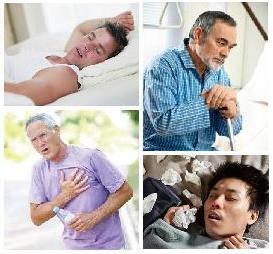If we consider automatic breathing patterns in sick people with various health problems, virtually all health conditions are characterized by ineffective breathing. Generally, many people know that people with asthma, COPD, panic/anxiety and cardiovascular diseases breathe too fast and inhale too much air even at rest while sitting. However, the same is true for cystic fibrosis, epilepsy, obesity and even cancer.
Indeed, available western medical evidence indicates that sick people with moderate degree of health problems breathe about 2-3 times more air than the physiological norms (which is 6 liters per minute). Consider this table with western respiratory data:
Minute Ventilation Rates in the Sick
Heart disease 15 (±4) l/min 22 patients Dimopoulou et al, 2001
Heart disease 16 (±2) l/min 11 patients Johnson et al, 2000
Heart disease 12.2 (±3.3) l/min 132 Fanfulla et al, 1998
Heart disease 14 (±4) l/min 88 Clark et al, 1995
Diabetes 12-17 l/min 26 Bottini et al, 2003
Diabetes 10-20 l/min 28 Tantucci et al, 1997
Asthma 15 l/min 8 Johnson et al, 1995
Asthma 14.1 (±5.7) l/min 39 Bowler et al, 1998
Asthma 12 l/min 101 McFadden & Lyons, 1968
COPD 12.2 (±1.9) l/min 10 Sinderby et al, 2001
Liver cirrhosis 11-18 l/min 24 Epstein et al, 1998
Hyperthyroidism 14.9 (±0.6) l/min 42 Kahaly, 1998
Cystic fibrosis 13 (±1.8) l/min 10 Bell et al, 1996
Cystic fibrosis 11-14 l/min 6 Tepper et al, 1983
Epilepsy 12.8 l/min 12 patients Esquivel et al, 1991
There are dozens more studies that have found the same effect. Note that none of these or many other studies showed or proved that some sick people with these and many other conditions may breathe normally. All these people breathe too much air, and this reduces their body oxygen levels.
If you observe breathing of sick people at rest just for 20-30 seconds, you will notice that their breathing is usually visible (likely chest and belly movements) and audible (possible panting, yawning, sneezing, wheezing, sighing, coughing, deep inhalations or exhalations). The mouth may be open, while the chest is usually moving for each breath.
For sick people, the durations of inhalations and exhalations, breathing rate, amount of air inhaled per breath and other parameters are individual. But most of them have the following parameters of the breathing cycle: inhalation (about 1.5-2 s), exhalation (1.5-2 s), no automatic pause; the depth of inhalation is about 700-1,000 ml; breathing rate is about 15-20 times per minute. Furthermore, it is easy to see that they are chest breathers.
Normal breathing is smaller and lighter: only 10-12 breaths per minute with around 500 ml for one breath. Since healthy people breathe slower, they have a period of no breathing (the automatic pause) after each exhalation: short and small diaphragmatic inhale -> relaxation for the exhalation -> the automatic pause (total relaxation).
Sick people, on the contrary, have forceful exhalations and then immediately have another inhalation. As tens of medical studies revealed, sick people have reduced body oxygenation due to their overbreathing.
Indeed, decades of medical research have clearly shows that hyperventilation cannot improve blood oxygenation, but causes losses in CO2 and this leads to vasoconstriction and the repressed Bohr effect (less oxygen arrives to cells). Furthermore, chest breathing makes oxygen transport much worse since the tiny diaphragmatic breathing provides 98% oxygen saturation in the arterial blood, while heavy chest breathing does not oxygenate lower parts of the lungs.
Body oxygen levels
A mildly sick person has only about 10-20 s for the body oxygen test (a special breath holding time test), instead of 40 s, as it is in healthy people who have normal breathing. (In order to measure body oxygenation is seconds, measure your breath holding time after usual exhalation and only until the first discomfort or without pushing yourself. The maximum breath holding time is about twice longer than the time for the test suggested here.)
Hence, all medical evidence and clinical experience show that virtually all sick people, with many common health problems, have heavy and deep breathing at rest with reduced body oxygenation. It is also proven that tissue hypoxia is the driving force for chronic inflammation and oxidative stress (internal pollution that is caused by free radicals).
Breathing retraining, towards the medical norm, gradually restores body oxygenation and eliminates symptoms of many chronic conditions. The Oxygen Remedy (the most effective breathing technique), the Buteyko breathing technique, the Frolov breathing device therapy, and some others can boost cell oxygen levels and eliminate chronic diseases.
What are the causes of hyperventilation?
Mouth breathing, chest breathin, mouth breathing during physical exercise, supine sleep, porr posture, overeating are some of the causes of overbreathing in modern man. Some other causes are provided below.
Resources
Cold feet and hands: causes and solutions - Web page from NormalBreathing.com
Mouth taping for night sleep - Instructions
Nose breathing prevents sports-induced asthma - Knol
NormalBreathing.com has hundreds of medical quotes and references, graphs and charts, tables and analysis of numerous respiratory techniques, results of clinical trials and free breathing exercises, lifestyle modules, manuals, techniques, and other resources to boost body oxygen levels and improve health.







